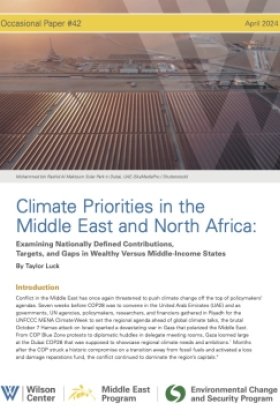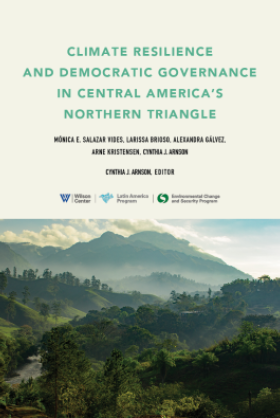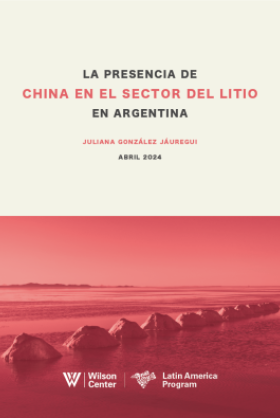Seeking Solutions for Water Scarcity in China
Bryan Lohmar, U.S. Department of Agriculture, Economic Research Service; Wang Rong, China University of Political Science & Law and the China Center for Law and Sustainable Development Research
Overview
By Linden J. Ellis, Jennifer L. Turner and Ma Tianjie
While serious air pollution, growing solid waste, and rapid biodiversity loss are quite severe in China, water problems are perhaps the country's greatest environmental and human health threat. In terms of water supply, China's statistics portray a grim picture: Per capita water availability in China is only one-quarter of the world average; and the rate is lower in northern China where in the Hai, Huai, and Yellow (Huang) river basins the per capita water availability is around 500 m3/year, half of what is internationally considered the standard for water stress. Over the past twenty years as water scarcity problems have grown in the north due to increasing demand, the policy response has often been to build water transfer projects and for the central government to limit water allocations to provinces, rather than to promote conservation through market mechanisms.
Conservation measures have been difficult due to considerable weaknesses in China's system of water rights and low water prices. The Ministry of Water Resources (MWR) created a water use permit system under the 1988 National Water Law and although regulation of these permits was strengthened the 2002 Water Law amendments, these permits have done little to curb waste and they do not allow for the trading of water. Beginning in 2006, the Chinese MWR has been cooperating with the Australian Department of Agriculture, Fisheries and Forestry (DAFF) to form a research team to design an overall framework for water rights and trading in China. At this April 8th Meeting, Rong Wang (China University of Political Science & Law and the China Center for Law and Sustainable Development Research)—the only Chinese legal expert on this MWR/DAFF research team—introduced the challenges and opportunities of building systems of water rights and trading in China. Over the past five years, our other speaker Bryan Lohmar (USDA ERS), has been working with the Chinese MWR, Chinese Academy of Sciences, the Australian Bureau of Agricultural and Resource Economics, and the University of California, Davis on a variety of studies examining water scarcity, water conservation policies, and agricultural production in China. He provided an overview of the findings of these water studies and discussed the implications for future agricultural production and trade.
WATER SHORTAGE IN CHINA
The average annual water shortage in China is 30 to 40 billion m3. It is most acute in the Huai, Hai and Yellow River Basins. Formerly the breadbasket of China, this area's water table was very high, and the Yellow River often breeched its banks flooding as far as Tianjin in the north and central Jiangsu to the south. This area accounts for 7.7 percent of China's water resources and one-third of its population and industry. The Hai, Huai, and Yellow basins also make up a major agricultural region, particularly for water-intensive crops such as wheat and corn, and it accounts for 40 percent of China's total cultivated land.
However, this area's current per capita water resources are well below the global average and half of the level considered water stress by the World Bank. Over 60 percent of renewable water resources in this area are diverted for human use: 40 percent diversion is often considered over consumption. In the Hai River Basin, the rate even reaches 90 percent. With downstream surface water increasingly polluted and unreliable, the majority of people now rely on groundwater, which since the 1980s is becoming increasingly privatized.
Over the past 20 years, demand for water has been increasing by 7.2 percent annually in the urban domestic sector and 5.2 percent annually in the industrial sector. Water pollution further intensifies water scarcity, with wastewater discharge doubling between 1980 and 2003, and the combined effect has led to conflicts between industry and agriculture, between urban and rural areas, and between regions. Such severe shortage demands that China's water policy shift from water engineering to water rights, says Wang.
Groundwater
Regulations regarding groundwater are often not enforced. Based on a survey of 400 villages in north China, Lohmar found that less than 5 percent of villages required permits to build wells, and only 2 controlled the volume of water being pumped. Also, although villages have the right to charge more for water to encourage conservation, less than 10 percent did. As a result, groundwater depletion is severe. Between 1995 and 2004, 75 percent of the Hai River Basin experienced depleting groundwater supplies and 26 percent averaged a decrease of 3 meters a year.
As wells dig deeper, the cost of groundwater increases because of the cost of electricity for pumping. This has led farmers to shift to high-value crops, such as fruit and vegetable production, even though these are risky and challenging crops. In India, farmers pay a lump sum for electricity for well, so price does not change with the depth of the well.
Surface Water and the Australian Bureau of Agricultural and Resource Economics Project
River basins are managed by the Ministry of Water Resources (MWR). Over the past decade the MWR has been working to promote large potential water saving through better management and allocation of the Yellow River, but provincial interests have often hindered progress. Lohmar noted that one study found that $1 billion could be gained by reallocating water from Ningxia in the upper Yellow River to downstream users. Half of this money could then be used to compensate Ningxia, and overall crop production would increase in the region.
Water prices at the local level prevent conservation from becoming a priority for the local MWR offices, Irrigation Districts. Because MWR sets water prices too low to cover operating costs, local Irrigation District offices have little ability or incentive to improve, maintain or monitor water delivery technology to reduce water use. As part of water management reform, local Water User Associations (WUAs) have been set up to manage individual projects under the Irrigation Districts with farmer elected managers. Private canal contracting, which requires the owner of the canal to make investments but allows the owner to collect fees for services and usage, also provide an incentive to maintain local infrastructure to prevent waste. Local governments in the Yellow River Basin are increasingly adopting these reforms, with greater than 35 percent of villages adopting them by 2001. However, Lohmar stressed that these reforms do not clearly affect the Irrigation Districts that are in charge of long-term planning and district-wide improvement.
The MWR and Ministry of Agriculture are both promoting water-saving irrigation technology, however, despite the fact that they are often profitable investments, adoption of new technology is increasing but remains low due to lack of incentives. Adoption of water-saving technology, such as drought resistant seeds or plastic sheeting, seems to be correlated to visits by extension officials rather than price incentives. Current pricing and delivery methods remain a major challenge to conservation.
Prices remain at 20-30 percent of the VMP for groundwater and even less for surface water, nor is it priced volumetrically. Also, farmers do not control delivery methods or volume, otherwise they could devise savings methods. Prices need to rise significantly to induce savings, however, raising them goes against the current strategy of lowering and removing costs for farmers and encouraging greater food production.
WATER RIGHTS
In 2006, Wang Rong served as the only legal expert on the Australia-China Water Entitlements and Trading Project, which studied 7 water rights pilot projects in China. The project identified 4 types of water rights and trading: (1) regional water allocation; (2) water withdrawal permits; (3) farmer's water rights allocation; and (4) water rights transfer, either between sectors or regions. Wang Rong and her colleagues determined that in order for China to implement these four types of projects on a national scale, China needs to define water rights
Regional Water Allocation
There were 8 cases of regional water allocation, which were formed to reduce water conflicts and establish water reallocation based on economic measures. They focused mainly on transferring water from the south to the north. They took place year-round in the north and during the dry season in southern areas. The study found that water allocation schemes did not match regulation schemes in many cases and water rights were not protected and secure.
Farmer's Water Rights Allocation
Farmer's water rights exist only in the north of China. Water tickets are issued to improve the implementation of collecting water charge and using water plan, however, the legal status of the water tickets and their relation to water rights is not clear.
Water Rights Transfers
The study found 4 examples of regional water rights transfers and 2 examples of sectoral (agriculture to industry) water rights transfers. All of these transfers were permanent, with no short-term or seasonal transfers. All of them relied on lined canals rather than improved irrigation or conservation of any kind. Lined canals prevent water from seeping into ground water to replenish regional hydrology and further deplete downstream resources. The transfers lacked a formal legal procedure and appropriate pricing, for example industry could buy water transfer for the cost of constructing the canal without taking into account the loss of productivity for farmers.
Hosted By

China Environment Forum
Since 1997, the China Environment Forum's mission has been to forge US-China cooperation on energy, environment, and sustainable development challenges. We play a unique nonpartisan role in creating multi-stakeholder dialogues around these issues. Read more
Thank you for your interest in this event. Please send any feedback or questions to our Events staff.








